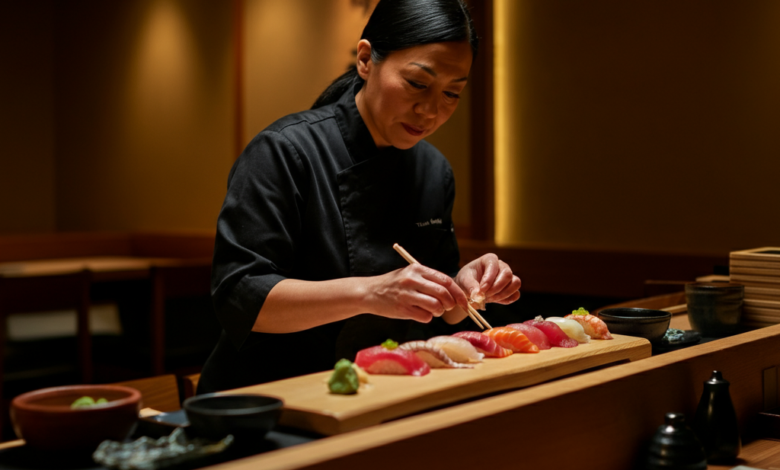Tia Morita: A Legacy That Redefines Sushi Culture

Introduction to Tia Morita: The Legacy and Significance in Sushi Culture
Sushi is as much an art as it is a cuisine, with its legacy steeped in tradition and innovation. But among the numerous names in sushi history, one that stands out is Tia Morita. Revered by sushi lovers and culinary experts alike, Tia Morita isn’t just a name—it’s a profound influence on how sushi is understood, crafted, and enjoyed.
This post will take you on an enriching journey through Tia Morita’s impact—from revolutionizing sushi-making techniques, curating superior ingredients, to shaping modern trends. Whether you’re a sushi connoisseur or a novice exploring this flavorful world, Tia Morita’s story offers something unforgettable.
The Art of Sushi Making: How Tia Morita Revolutionized Traditional Techniques
To understand the magic behind Tia Morita, we first have to explore the art of sushi-making. Traditional sushi-making involves precision, discipline, and years of practice. While preserving these principles, Tia Morita brought innovation to the craft, redefining its possibilities.
Precision Meets Innovation
Tia approached sushi-making with an eye for detail, elevating methods that had been handed down for centuries. One of Morita’s key innovations was in rice preparation. The precise balance of vinegar, sugar, and temperature became a signature standard, ensuring every grain enhanced the seafood’s freshness and flavor profile.
Another aspect that defined Tia Morita was “fusion experimentation.” While staying loyal to sushi’s Japanese roots, Tia wasn’t afraid to incorporate flavors and ingredients from global cuisines. This effectively bridged the gap between traditional and contemporary sushi, inspiring many chefs worldwide to do the same.
Understanding Tia Morita’s Ingredients
Sushi starts with ingredients—and for Tia Morita, the ingredients were sacred. The hallmark of Morita’s sushi was using the freshest seafood, selecting cuts meticulously for quality and compatibility with flavor pairings.
The Search for the Best Seafood
Known for sourcing directly from sustainable fisheries, Tia Morita ensured that only the highest-quality seafood made it to the sushi counter. Whether it was buttery tuna, delicate mackerel, or sweet shrimp, every ingredient was selected to shine on its own and in harmony with the rice.
Morita also emphasized seasonal ingredients—everything on the menu reflected the freshness of the time of year, a practice that still inspires sushi restaurants worldwide.
Beyond Seafood – The Importance of Rice and Nori
While seafood takes center stage in sushi, Tia Morita valued the supporting actors like rice and nori (seaweed). Morita pioneered the specific aging techniques for sushi rice, balancing texture and stickiness perfectly. Meanwhile, the nori used was sourced from the best bays in Japan, crisp and aromatic.
The Tia Morita Experience: A Journey through Sushi Perfection
Dining at an establishment influenced by Tia Morita wasn’t just eating—it was a ritual. Sushi was served piece by piece, allowing the diner to savor one flavor at a time.
Servers shared the story and seasonality behind each creation, fostering deep respect for the process and thought behind the dish. Watching the chef work behind the counter—a performance of slicing, rolling, and plating—immersed guests in the art form.
Such experiences have stood the test of time and continue to represent the essence of sushi dining worldwide.
Tia Morita’s Influence on Modern Sushi Trends and Practices
You might wonder, “How does Tia Morita’s legacy translate to today’s sushi?” Morita’s influence lives on in modern sushi bars and fusion restaurants.
DIY Sushi at Home
Tia’s emphasis on accessibility encouraged many home chefs to experiment with making sushi themselves. Sushi kits now include tasting guides inspired by Morita’s philosophy on flavor and ingredient balance.
Sushi Fusion
Cultural fusion in sushi—think jalapeño tuna rolls or truffle salmon hand rolls—can trace much of its ethos to Tia Morita’s fearless incorporation of diverse flavors alongside traditional practices.
Sustainable Practices
Finally, Tia Morita’s advocacy for sustainability has become a gold standard in the seafood world. Sushi chefs today not only source sustainably but also educate diners about the origin and ethical choices behind their ingredients.
Exclusive Interview with a Tia Morita Sushi Chef
We spoke with Chef Hiro Tanaka, who worked alongside Tia Morita and continues her legacy in his own sushi restaurant in Kyoto.
Q: What did you learn from Tia Morita that resonates with you today?
A: “Tia taught me that making sushi isn’t just about technique—it’s about respect. Respect for the fish, the rice, and most importantly, the person who eats it. Every element has to work in harmony.”
Q: What advice do you have for someone making sushi at home?
A: “Start simple. Focus on quality over quantity. If your fish is fresh and your rice perfect, even the simplest sushi will shine. Tia always emphasized clarity in flavors—never hide behind heavy sauces or too many toppings.”
Where to Experience Tia Morita’s Legacy
Want to immerse yourself in Tia Morita’s influence? Here are the top sushi destinations to explore her philosophy first-hand.
1. Kyoto Sushi Atelier (Kyoto, Japan)
Run by Chef Hiro Tanaka, this restaurant is a living homage to Tia Morita. Every bite tells a story of tradition blended seamlessly with artistry.
2. Sora Fusion Sushi Bar (San Francisco, USA)
Known for innovative flavor pairings, their menu includes a special Tia Morita-inspired roll featuring yuzu-marinated tuna and wild-caught crab.
3. Omakase Eden (London, UK)
This spot is renowned for replicating Tia-inspired omakase (chef’s choice) dining, bringing subtle yet powerful modern touches to traditional sushi practices.
Sushi Perfection in Every Bite
Tia Morita’s legacy reminds us that sushi is far more than food—it’s a connection between culture, seasons, and craftsmanship. From sourcing the finest ingredients to creating rituals around dining, Morita elevated sushi into a globally cherished art form.



